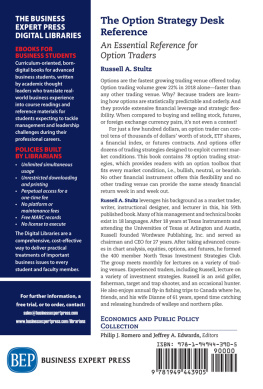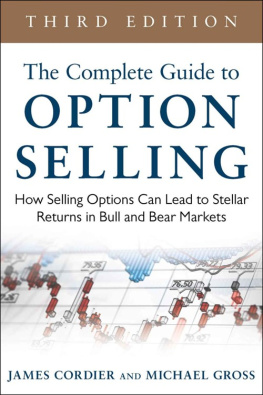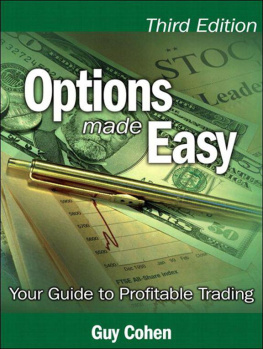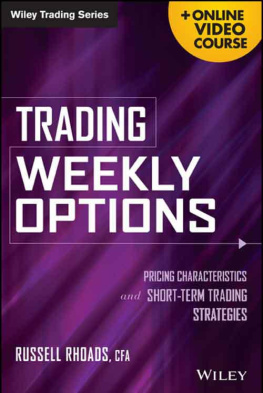Option Chain Analysis
The CT Scan of Derivative Market
Rajiv LB Roy
Copyright 2020 Rajiv LB Roy
All rights reserved
No part of this book may be reproduced, or stored in a retrieval system, or transmitted in any form or by any means, electronic, mechanical, photocopying, recording, or otherwise, without express written permission of the publisher.
Cover design by: Rajiv LB Roy
Author email: ralbi.roy@gmail.com
Dedication
This book is dedicated to my wife, Arpana for your love, encouragement and support and my son Neevan whose sunny spirit kept me going.
Contents
Preface
We all know the basic rule of thumb in share trading is buy low sell high . But the biggest question is how to know the low and high of the market? Is it really possible to know the bottom and the peak of the market? The answer is a big no. It is next to impossible to identify the low and high of a market.
The next question that arises is why then all the traders and investors are running after the market analysis techniques? They do fundamental analysis, technical analysis, derivative data analysis and many more. Is it really meaningful to do all these analysis? The answer lies in another question. Let me ask you that first. Why does the Government of our country have a metrological department to forecast the weather? Are they able to predict the weather with one hundred percent accuracy? The answer is No. Weather forecast helps the businesses that are dependent on the weather to take informed decisions about their business. This helps them to reduce their risk as well as increase the potential for profit.
The same judgment applies to stock trading also. Though we cant predict the exact high and low, we can at least buy any stock near the low and sell it near the high with the help of market analysis. This way we can make some profit from the market. If you do not analyze the market and start trading, the probability of losing money becomes very high. Analyzing the market not only makes you to minimize the risk but also enhances the chance of maximizing profits. That is what all of the successful traders do. And I believe, it is always wise to follow the successful one if you have limited knowledge in that field.
Let me remind you here the subtitle of the book The CT scan of derivative market. Well, allow me explain it to you. By looking at the CT scan report, a physician can very easily detect the disease that a patient is suffering from. The report tells almost everything about the patients physique. Whether the body is functioning properly or is there any abnormality going on? Accordingly the physician takes literate decision and recommends treatment. Likewise, option chain shows everything about the derivative market viz . fresh positions, long unwinding, short covering, quantity etc . Having seen on the option chain, a trader can forecast the market trend and accordingly take trading decisions. This way, traders can maximize profits and minimize losses.
In this book we will discuss some basics of option trading viz . open interest, volume, option chain analysis, some option strategies suitable for different market scenarios etc . Moreover, we will give more emphasis on interpretation of open interest and some successful option trading strategies. I assume that you picked up the book owing to some prior knowledge about option trading. Dont get disheartened if you are ignorant of derivative market as I shall be discussing a few terminologies related to option trading.
At this point, I would love to mention that I have launched a few courses on Udemy also on option trading and day trading. All the courses are in Hindi and if you are interested in learning through video lectures I urge you to go through the course description.
Anyway, lets get back to the main topic. Before starting to analyze the market permit me to ask one simpler question. Do you know who the winners in the world of derivative market are? The answer is quite simple and I assume that you know it well. Your prompt answer would be FIIs, DIIs and the Pro traders. Most of the time, they predict the price movement of the market accurately. Then why dont we just simply follow them. If we could know where they are making positions, our half job is done. Isnt it? Now, the great question is how to know whether they are sitting with the long positions or short positions? If they built long positions, chances are there that price will move up. Contrarily, if they created short positions, the market may fall. Here, we will discuss how to know about their positions? We will illustrate how to find intraday trend as well as short term trend of any security with the help of open interest data.
Introduction
What is an option?
An option is a contract between two parties, a buyer and a seller in which the buyer has the right but not the obligation to buy or sell the underlying asset at a specific price on or before a certain date. In the world of finance, it is called derivative of a financial instrument because its value is derived from another asset. Unlike, a stock or bond, an option is also a security.
Still confused? Actually, the concept of option prevails in many situations in our every life. Let us take an example to know what exactly an option is? Say, you find a flat in your dream location and you would like to purchase it. The cost of the flat is suppose Rs. one crore. Unfortunately, you dont possess the required cash and unable to arrange it for another six months. But you dont want to miss the flat. So, you talk to the builder and made an agreement that offers you an option to buy the flat in six months for a price of Rs. one crore. But for this option you need to pay an upfront fee of Rs. one lakh (say).
Now, think of two situations that might arise
One, you realized that the flat is situated in a prime location of your dream city, the market value skyrockets to Rs. 1.10 crore within six months. Since the builder sold an option, he is obliged to sell the house at Rs. 1 crore. So, you end up making a profit of Rs. 9 lakhs (1.1 Cr. 1Cr. 1 L) without even buying the flat.
Two, due to some unforeseen circumstances such as demonetization or pandemic, you discovered that the market value of the house fell to Rs. 90 lakhs only. Now, if you execute your option i.e. you buy it at Rs. 1 Crore, you incur a loss of Rs. 10 lakhs instantly. Fortunately, you bought the option, which implies you are under no obligation to go through the contract. But off course, you still lose Rs. 1 lakh, the price of the option.
From the above example, two important points become clear. First, when you buy an option, you have the right but you have no obligation to execute the contract. You can always allow expiration date to go and let the agreement becomes worthless. When it happens, you lose 100% of your investment that you used to pay for the option. Second, an option is a contract or agreement that deals with an underlying asset. This is why options are called derivatives, which mean the value of option is derived from something else called underlying asset. The underlying asset is an asset on which the value of the derivative is dependent. In the above example, the flat is the underlying asset. In financial market, most of the time, the underlying asset is either a stock or index.
Types of option
There are two types of option: call and put option
Call option: It gives the buyer the right, not the obligation to buy an asset at a certain price within a specific period of time. The buyer pays a premium to the seller for the right to take delivery of the underlying asset. Call options are similar to having a long position on a security or stock.
Put option: It gives the buyer the right, but not the obligation to sell the underlying at the stated price within a specific period of time. Unlike call option, put option buyer also pays a premium (fee) for the right to execute the contract. Put option is similar to having a short position on a stock. Put buyers expect that the stock will fall substantially before the option expires.








